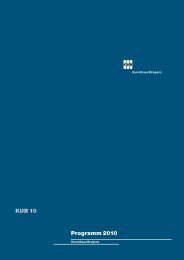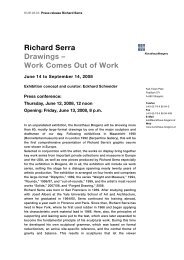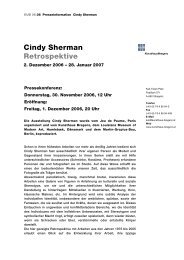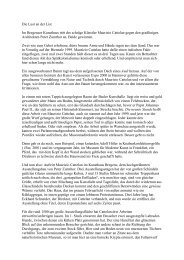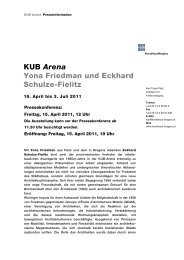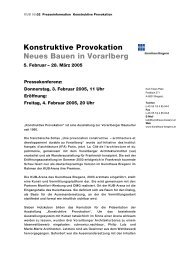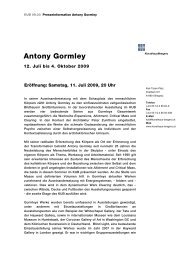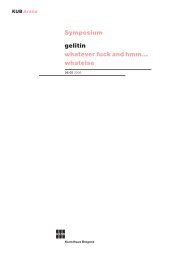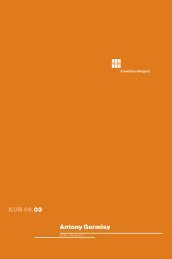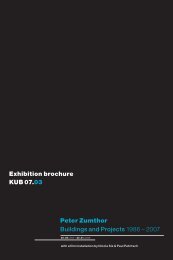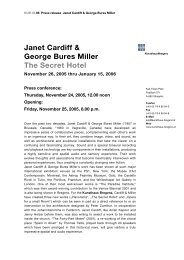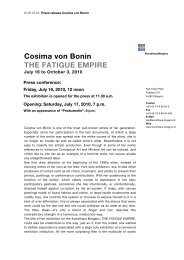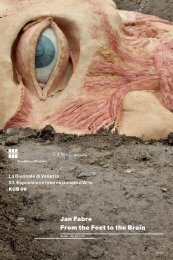Maurizio Cattelan
Maurizio Cattelan
Maurizio Cattelan
You also want an ePaper? Increase the reach of your titles
YUMPU automatically turns print PDFs into web optimized ePapers that Google loves.
KUB 08.01 Press release <strong>Maurizio</strong> <strong>Cattelan</strong><br />
<strong>Maurizio</strong> <strong>Cattelan</strong><br />
February 2 to March 24, 2008<br />
Opening: Friday, February 1, 2008, 8.00 p.m.<br />
Press conference:<br />
Thursday, January 31, 2008, 12 noon<br />
The Pope felled by a meteorite as if by the hand of God (“La Nona Ora,”<br />
1999), a miniature model of the artist in a Beuysian felt suit, hanging<br />
helplessly from a clothes rack (“La Rivoluzione Siamo Noi,” 2000), or the<br />
artist breaking into the temple of art through the museum floor (Untitled,<br />
2001) – <strong>Maurizio</strong> <strong>Cattelan</strong>, in a mixture of Don Camillo, Pinocchio and court<br />
jester, always carries his pictorial statements to extremes so that the realistic<br />
depiction of well-practiced social and art world conventions tips over into the<br />
absurd and ridiculous. Rather theatrical and ephemeral in his actions,<br />
objects, and installations, but deploying ironic sophistication and unexpected<br />
turns, the artist spares no taboo in unmasking deceitfulness.<br />
Born in 1960 in the North Italian university town of Padua, he started his<br />
career in the eighties creating anti-functional design objects before deciding<br />
to work in the art world, which, in his own words, he found “much more<br />
appealing.” Since then, <strong>Cattelan</strong> has become an internationally renowned<br />
artist, even though he would not describe himself as one. However, without<br />
contradictions, provocations, and simultaneously existing differing truths, his<br />
work would not be what it is. This strategy, together with a visual power<br />
which imprints itself onto our memory, has led to the appearance of his<br />
actions and sculptures in the most important international art institutions and<br />
to participation in numerous significant group exhibitions and biennials.<br />
Since 1993 when <strong>Maurizio</strong> <strong>Cattelan</strong> settled in New York, he has alternatingly<br />
lived and worked both there and in Milan. Not owning a studio, he works in<br />
situ, as exhibitions offer him exactly the challenge needed to “find” new<br />
works, which are subsequently fabricated by others rather than being made<br />
by the artist himself. In this sense, he really is one of Duchamp’s greatgrandchildren.<br />
In contrast to Duchamp, however, he does not relate the idea<br />
of the readymade to the selecting of found objects which are then declared<br />
as artworks, but views experienced reality in its irreconcilable, often absurd<br />
contradictions as a large readymade which he quarries for ideas. “We can<br />
find a philosophical idea through television, which we watch every day,” says<br />
<strong>Cattelan</strong>. He draws upon his own biography and links this to an Italian<br />
Karl-Tizian-Platz<br />
Postfach 371<br />
A-6901 Bregenz<br />
Telefon<br />
(+43-55 74) 4 85 94-0<br />
Fax<br />
(+43-55 74) 4 85 94-408<br />
E-Mail<br />
kub@kunsthaus-bregenz.at<br />
Web<br />
www.kunsthaus-bregenz.at
2/10<br />
KUB 08.01 Press release <strong>Maurizio</strong> <strong>Cattelan</strong><br />
attitude to life that continually swings from banality to extreme devoutness<br />
and holy veneration. And he finds his subjects in the art world’s overheated<br />
mannerisms and rituals as much as in the social and political fractures of<br />
society.<br />
For <strong>Cattelan</strong>, style means nothing more than a particular artistic attitude that<br />
can be translated into different media, linguistic forms, and visual solutions.<br />
An artist like him who has made ironic distance the principle of his practice<br />
must rely on flexibility, but never on predictable conclusions. If on occasion<br />
this does not suffice he is happy to steal other artists’ ideas or even a whole<br />
exhibition. Such was the case with a project done for de Appel Gallery in<br />
Amsterdam.<br />
<strong>Maurizio</strong> <strong>Cattelan</strong> is a storyteller. Storytellers do not carry out revolutions, but<br />
they may inspire them. Each image that he generates through his actions and<br />
sculptures resembles a shared membrane between his and our emotions. In<br />
this, <strong>Cattelan</strong> really relies on an intensive working process of condensing and<br />
refining the ideas, the outcome of which is always an “image” full of narrative<br />
inventions. Why for example are the hands of the child in “Charlie Don’t Surf”<br />
(1997) nailed to the table with pencils? <strong>Cattelan</strong> loves these little stories,<br />
which emerge from within deeper levels of the work. They make the work<br />
lively and are triggers for individual stories, which vary from viewer to viewer.<br />
Despite all the variety of ideas and works, there are two founding principles<br />
in his oeuvre. <strong>Maurizio</strong> <strong>Cattelan</strong> differentiates between works which function<br />
as an idea or project, such as the footballers’ memorial wall in London on<br />
which the results of all the England team’s lost games are engraved or the<br />
figure with a Picasso mask which greets visitors at the entrance to MoMA in<br />
New York, and those works which are transformed into highly memorable<br />
images. Within this category fall such works as “Novecento” from 1997,<br />
which shows a horse hanging from the ceiling, or “Him” (2001) with Hitler as<br />
a boy kneeling repentantly.<br />
In his work, which in equal measure encompasses both humor and humility,<br />
it is this tragic but comical keynote that evokes strong, but sometimes also<br />
oppressive emotions in us, especially when <strong>Cattelan</strong>, in all his diversity,<br />
repeatedly centers on death as his central motif. In this the artist is very close<br />
to his ancestral and national roots. According to Francesco Bonami, death is<br />
“the very last moment of pathetic intimacy, the most radical way to avoid<br />
public responsibility.”<br />
Death is also the major subject of the exhibition at Kunsthaus Bregenz. For<br />
the first time, <strong>Maurizio</strong> <strong>Cattelan</strong> has allowed a total architectural installation<br />
to be part of his work. By making very few spatial interventions and with<br />
three groups of work especially created for Bregenz, he changes the building
3/10<br />
KUB 08.01 Press release <strong>Maurizio</strong> <strong>Cattelan</strong><br />
into a burial chamber, which transforms the building’s auratic potential into a<br />
borderland between disquieting anxiety and ironic distance.<br />
As usual, <strong>Cattelan</strong> does not want to disclose too much about his exhibition in<br />
advance. Yet, he wants his work to be located somewhere between<br />
“softness and perversity,” he says: “It should be tender, comforting and<br />
seductive and yet corrupted, twisted and consumed.”
4/10<br />
KUB 08.01 Press release <strong>Maurizio</strong> <strong>Cattelan</strong><br />
KUB-Publications<br />
<strong>Cattelan</strong><br />
This publication conceived by <strong>Maurizio</strong> <strong>Cattelan</strong> is both a book and an<br />
artwork. Like Duchamp’s “Boîte-en-valise,” it is a survey of <strong>Cattelan</strong>’s work.<br />
The artist designed the DIN A3 plates to fit in a fabric envelope; the handillustrated<br />
text and images carried out on the artist’s order emphasize the<br />
character of an artist’s book. Bice Curiger, chief editor of “Parkett” and<br />
curator at Kunsthaus Zurich, has contributed a well-informed essay.<br />
<strong>Maurizio</strong> <strong>Cattelan</strong><br />
German/English<br />
Ed. by <strong>Maurizio</strong> <strong>Cattelan</strong><br />
Graphic design: Christophe Boutin under the supervision of <strong>Maurizio</strong> <strong>Cattelan</strong><br />
With an essay by Bice Curiger<br />
40 pages in fabric envelope, 43 × 32.5 cm<br />
Published by Three Star Books, Paris, in collaboration with Kunsthaus<br />
Bregenz and Museum für Moderne Kunst, Frankfurt<br />
Publication date: February 2008<br />
Price: ca. 95 €<br />
Peter Zumthor<br />
Kunsthaus Bregenz<br />
The book on the Kunsthaus Bregenz that was published in close<br />
collaboration with Peter Zumthor in 1997 has been reprinted on the occasion<br />
of the exhibition “Peter Zumthor. Buildings and Projects 1986 – 2007.”<br />
Peter Zumthor<br />
Kunsthaus Bregenz<br />
5th, unaltered edition<br />
German/English<br />
Ed. by Kunsthaus Bregenz, archiv kunst architektur, Edelbert Köb<br />
With text contributions by Peter Zumthor and Friedrich Achleitner<br />
Photos by Adolf Bereuter, Hélène Binet, Gerald Zugmann<br />
107 pages, 20.2 × 16.4 cm ; Price: 16.80 €
5/10<br />
KUB 08.01 Press release <strong>Maurizio</strong> <strong>Cattelan</strong><br />
KUB-Calendar 2008<br />
To commemorate its tenth anniversary, the Kunsthaus Bregenz has for the<br />
first time published a calendar with installation views of twelve characteristic<br />
exhibitions that have been shown at the Kunsthaus Bregenz since 1997.<br />
KUB-Calendar 2008<br />
Format: 55 × 40 cm<br />
12 calendar pages, 2 pages of text<br />
Price: 34 €<br />
Online-shop: www.kunsthaus-bregenz.at
6/10<br />
KUB 08.01 Press release <strong>Maurizio</strong> <strong>Cattelan</strong><br />
KUB-Editions<br />
<strong>Maurizio</strong> <strong>Cattelan</strong><br />
Bregenz<br />
The edition, which has been designed and commissioned by<br />
<strong>Maurizio</strong> <strong>Cattelan</strong>, is printed in various techniques on heavy grade<br />
handmade paper and is based on of a hand painted original work,<br />
which is part of the exhibition.<br />
<strong>Maurizio</strong> <strong>Cattelan</strong><br />
Bregenz, 2008<br />
A limited edition of 45 copies, numbered and signed, size: 50 x 40 cm<br />
Subscription price during the exhibition: € 2,200<br />
Price after the exhibition: € 2,700; price incl. 10% VAT, plus postage and<br />
packaging<br />
published by Kunsthaus Bregenz<br />
Re-Object/Mythos<br />
Portfolio<br />
The portfolio was put together for the exhibitions “Re-Object” and<br />
“Mythos.” It consists of 8 works using different techniques, each<br />
in the format of 81 × 61 cm, encased in a protective aluminum box.<br />
Further information including photos and technical details on all<br />
the works are available on request.<br />
Portfolio<br />
Re-Object/Mythos | 2007<br />
Marcel Duchamp, Gerhard Merz, Damien Hirst, Jeff Koons;<br />
Joseph Beuys, Matthew Barney, Douglas Gordon, Cy Twombly<br />
Limited edition of 45 pieces, numbered and signed, size: 81 × 61 cm<br />
Price on request (incl. 10% VAT), plus forwarding expenses<br />
Published by Kunsthaus Bregenz
7/10<br />
KUB 08.01 Press release <strong>Maurizio</strong> <strong>Cattelan</strong><br />
Douglas Gordon<br />
The path of least resistance<br />
This is a special edition conceived for the tenth anniversary of the Kunsthaus<br />
Bregenz. The title makes reference to a work that Douglas Gordon created<br />
for the exhibition “Mythos.”<br />
Douglas Gordon<br />
The pathe of least resistance, 2007<br />
Bracelet, silver (925/000), brushed finish with engraving;<br />
outside: text “the path of least resistance”;<br />
inside: “Douglas Gordon | 2007 | Kunsthaus Bregenz”<br />
Ladies’ model: 147 × 10 mm; Men’s model: 165 × 10 mm<br />
Limited edition of 82 pieces, numbered and signed<br />
Price: 950 € incl. 10% VAT, plus forwarding expenses<br />
Published by Kunsthaus Bregenz
8/10<br />
KUB 08.01 Press release <strong>Maurizio</strong> <strong>Cattelan</strong><br />
KUB-Billboards<br />
Daniel Schwartz<br />
Turning Away<br />
January 21 to March 24, 2008<br />
Opening: Thursday, February 7, 2008, 6.00 p.m.<br />
Kunsthaus Bregenz, lecture hall, first basement<br />
Over the past ten years, Daniel Schwartz, born in Switzerland in 1955, has<br />
explored Central Asia and the surrounding regions including Afghanistan,<br />
Iran, Mongolia, and Kashmir with his camera. In his photojournalism, essays,<br />
and books Schwartz concentrates on “extended time” (Fernand Braudel). His<br />
art is informative; his photojournalistic work does not merely react to events<br />
but actively seeks out and follows political developments and their social<br />
impacts over extended periods of time and over vast geographic areas. “For<br />
years my art has told stories about places of the past and the everyday as<br />
well as about the journey there. Since every traveler finds his final resting<br />
place beside the road, my images of people turning away are also<br />
encounters with death – the last of all turning aways.”
9/10<br />
KUB 08.01 Press release <strong>Maurizio</strong> <strong>Cattelan</strong><br />
Partners and Sponsors<br />
The Kunsthaus Bregenz would like to thank its partners for their generous<br />
financial support and the cultural commitment that goes along with it.<br />
Presenting<br />
sponsor<br />
Main sponsor<br />
of the Kunsthaus Bregenz<br />
Cultural bodies<br />
Hypo Landesbank<br />
Vorarlberg<br />
Sponsor of the<br />
KUB Arena<br />
Kulturhäuser Betriebsgesellschaft<br />
mbH<br />
With kind support from<br />
Gesellschaft der<br />
Freunde des<br />
Kunsthaus Bregenz
10/10<br />
KUB 08.01 Press release <strong>Maurizio</strong> <strong>Cattelan</strong><br />
Kunsthaus Bregenz<br />
Venue/Organizer:<br />
Kunsthaus Bregenz<br />
Karl Tizian Platz<br />
A-6900 Bregenz<br />
Exhibition concept:<br />
Eckhard Schneider,<br />
<strong>Maurizio</strong> <strong>Cattelan</strong><br />
Director:<br />
Eckhard Schneider<br />
Curator:<br />
Rudolf Sagmeister<br />
Press and public relations:<br />
Birgit Albers<br />
Phone: (+43-55 74) 4 85 94-413<br />
Fax: (+43-55 74) 4 85 94-408<br />
b.albers@kunsthaus-bregenz.at<br />
Press photos to download:<br />
www.kunsthaus-bregenz.at<br />
Art Education:<br />
Winfried Nußbaummüller<br />
Phone: (+43-55 74) 4 85 94-417<br />
Fax: (+43-55 74) 4 85 94-408<br />
w.nussbaummueller@kunsthausbregenz.at<br />
Publications:<br />
Katrin Wiethege<br />
Phone: (+43-55 74) 4 85 94-416<br />
Fax: (+43-55 74) 4 85 94-408<br />
k.wiethege@kunsthaus-bregenz.at<br />
Editions:<br />
Caroline Schneider<br />
Phone: (+43-55 74) 4 85 94-444<br />
Fax: (+43-55 74) 4 85 94-408<br />
c.schneider@kunsthaus-bregenz.at<br />
Opening hours:<br />
Tuesday – Sunday 10 a.m. – 6 p.m.<br />
Thursday 10 a.m. – 9 p.m.



